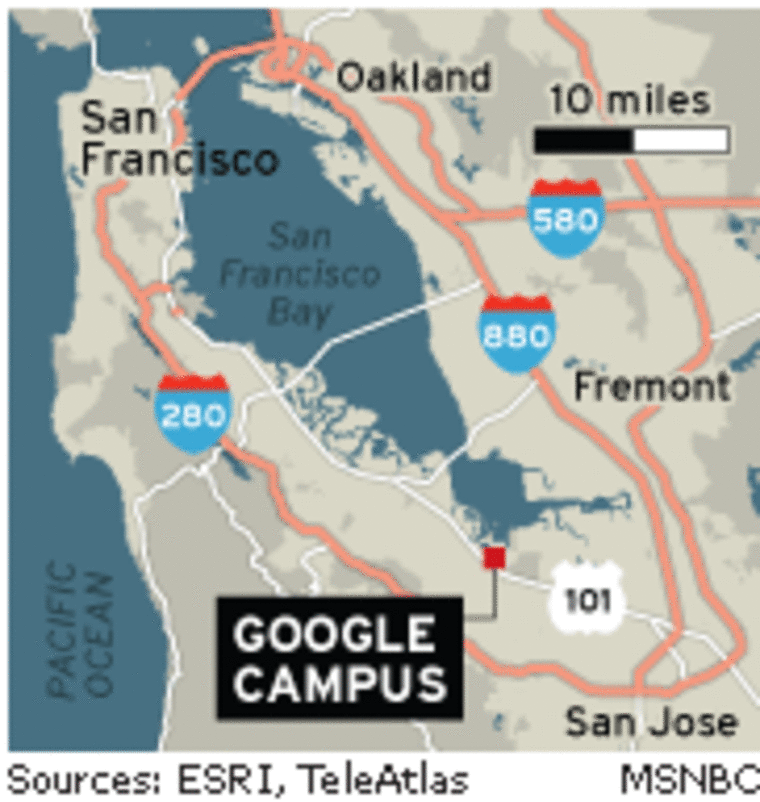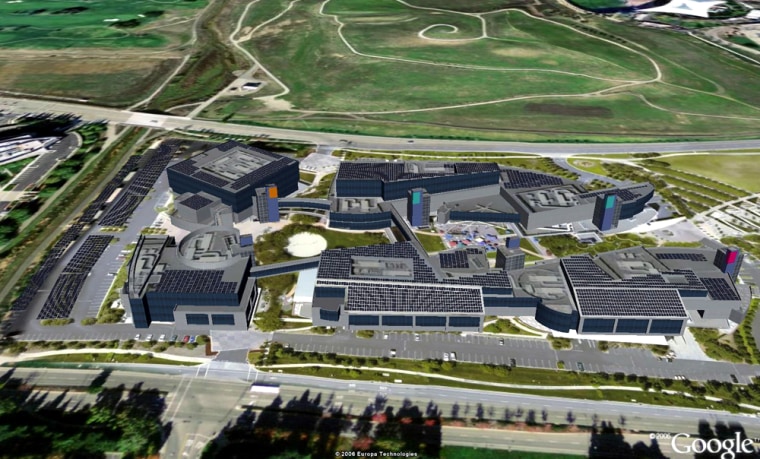Google Inc. is converting its renowned headquarters to run partly on solar power, hoping to set an example for corporate America.
The undertaking will be the largest solar project by a U.S. company. Google believes the sun eventually can deliver as much as 30 percent of the power at its 1-million-square-foot campus in Mountain View — a suburb about 35 miles south of San Francisco.
“We wanted to dispel the myth that you can’t be both green and profitable,” said David Radcliffe, vice president of real estate at Google.

The ambitious project will require installing more than 9,200 solar panels on a high-tech mecca nicknamed the "Googleplex." After leasing the offices for several years, Google bought the campus for $319 million earlier this year.
Once they're in place next spring, the solar panels are expected to produce about 1.6 megawatts of electricity, or enough power to supply about 1,000 homes.
Google wouldn't disclose the project's cost, but it won't strain a company with nearly $10 billion in cash.
Copycats encouraged
The anticipated savings from future energy bills should enable Google to recoup the solar project's costs in five to 10 years, estimated Radcliffe.
"We hope corporate America is paying attention. We want to see a lot of copycats," Radcliffe said.
Energy costs are a major concern at Google, which already consumes a tremendous amount of power to run the computer farms that keep its search engine humming.
But while the move marks a major demonstration of support for alternative energy, the project may only make only a small dent in the overall amount of energy consumed by Google. A utility industry rule of thumb is that data centers consume 10 times more electricity than buildings used to house office workers. The solar panels will only be supplying the office workers.
Google co-founders Larry Page and Sergey Brin also are big supporters of alternative energy. The billionaires began driving hybrid cars shortly after they hit the mass market. Page also is among the investors in Tesla Motors Inc., a Silicon Valley startup developing a sports car that runs on electricity.
Despite technological advances since the first photovoltaic cells were invented 50 years ago, solar power is still two to three times more expensive than fossil fuels in the U.S. and relies on government subsidies to compete.
The solar energy industry nevertheless is expected to grow from $11 billion in 2005 to $51 billion in 2015, estimated Clean Edge Inc., a market research firm.
Other high tech solar
Earlier this year, Google rival Microsoft got the jump on Google with a 2,288-panel solar system at its research site in Mountain View that is expected to produce 480 kilowatts at peak capacity, the first large-scale use of solar power at any Microsoft office worldwide. (Microsoft is a partner in the joint venture that operates MSNBC.com)
Silicon Valley’s Cypress Semiconductor, majority owner of solar cell maker SunPower Corp., has a 336-kilowatt system generating more than 10 percent of its corporate-office electricity needs, spokesman Matt Beevers said.
The Google job is being handled by Pasadena-based EI Solutions, part of a high-tech incubator run by entrepreneur Bill Gross, whose idea to link ads to search engine requests during the 1990s inspired the business model that generates most of Google's profits.
Most of the solar panels will sit on the rooftops of office buildings in the Googleplex. Others will provide shaded parking as part of newly constructed solar-panel canopies over existing Google car parking lots.
Sharp Electronics is supplying 9,212 solar panels for the Google project. Sharp Corp., parent of the solar panel maker, has a 5.2 megawatt solar generation system, the world’s largest corporate solar system, at a factory in Kameyama, Japan.
The world’s largest dedicated solar-powered generation station is a 12-megawatt facility in Arnstein, Germany, near Frankfurt. The top U.S. dedicated solar facility generates 4.6 megawatts and sits in the Arizona desert near Tucson, according to a solar generation database compiled by PVResources.com.
